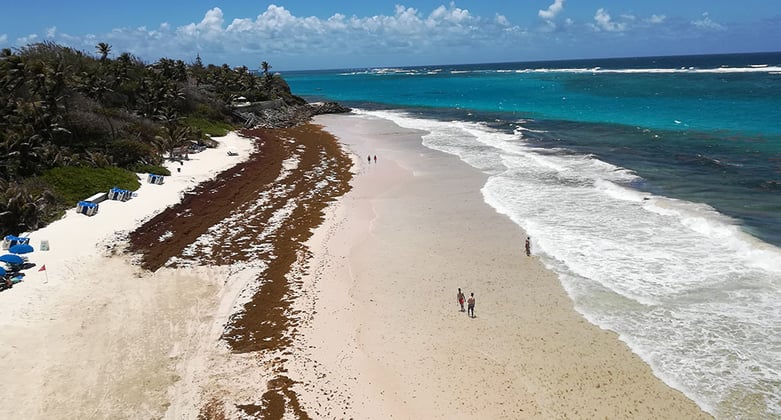Thick, brown, smelly sargassum seaweed has created a state of emergency in some parts of the Caribbean, wreaking havoc from the Gulf shores of Texas to Tobago and the Dominican Republic in the Caribbean, and the popular hotspots along Mexico’s Riviera Maya like Cancun.
The UMHS Endeavour looks at why seaweed is such a problem this summer in the Caribbean, what causes it, and what’s being done to help communities clean up local beaches and bays in time for the coming tourist season in fall and winter.
To date, the UMHS Endeavour has heard no reports from students at Caribbean medical schools in St. Kitts and Nevis about seaweed clogging beaches in the twin island nation this summer, but TripAdvisor.com had customer reviews of a seaweed problem in the waters around a popular St. Kitts resort back in spring 2012.
Seaweed Clogs Caribbean & Kills Wildlife
In late June 2015, Newsweek reported a problem with sargassum seaweed clogging beaches from Galveston, Texas to tiny Tobago in the Caribbean.
At an August 4, 2015 news conference, the Tobago House of Assembly “declared a natural disaster and announced a $3 million budget to tackle the influx of seaweed on the island’s Atlantic coast,” Laura Begley Bloom wrote in a Yahoo Travel article.
Yahoo Travel said that on July 30, 2015, Mexico’s Environment Department said the country would hire 4,600 temporary workers and spend $9.1 million on the Riviera Maya (the Caribbean coast). Cancun has already cleaned up approximately 100 tons of seaweed.
Seaweed piles reached four feet tall in parts of Antigua, Yahoo Travel wrote. On the island of Barbados, 42 turtles died from suffocation after being caught in seaweed.
The seaweed emits a strong, putrid odor as it rots in the hot sun. Britain’s The Guardian wrote in an August 10, 2015 article that the seaweed smells like rotten eggs and attracts biting sand fleas. Sargassum seaweed gets its name from the Portuguese word for “grape.”
The seaweed has piled up as high as 10 feet on some Caribbean beaches, the Guardian said.
As high tourist season approaches for fall and winter, Caribbean officials are concerned the seaweed will hurt tourism. The Guardian reported that officials want an emergency meeting of the 15-nation Caribbean Community to help combat the problem before the season starts.
“This has been the worst year we’ve seen. We need to have a regional effort because this unsightly seaweed could end up affecting the image of the Caribbean,” Christopher James, chairman of the Tobago Hotel and Tourism Association, told the Guardian.
Soil Emptying Into Ocean from Amazon Deforestation May Be Cause
Many theories exist on the cause of the growing sargassum seaweed problem, the Guardian said. They include the warming ocean temperatures and “changes in the ocean currents due to climate change.” Other researchers say the seaweed is being caused by “increased land-based nutrients and pollutants washing into the water, including nitrogen-heavy fertilizers and sewage waste that fuels the blooms,” the Guardian said.
Mats of drifting sargassum seaweed from the Caribbean and Atlantic have been reported “as far away as Sierra Leone and Ghana,” the Guardian said.
Newsweek’s article said increases in sargassum were initially reported in the Greater and Lesser Antilles in 2011 and 2012.
“The problem appears to have begun many miles away,” Melissa Gaskill wrote in Newsweek. “In recent years, the Amazon basin has experienced some of the world’s highest rates of deforestation. And without vegetation to hold soil in place, rain washes that soil and whatever it contains into streams and rivers. So when the Amazon basin saw greater than normal amounts of rain in 2011 and 2012, unusually high levels of nutrients such as nitrogen and phosphorus washed into Atlantic waters around the mouth of the Amazon River off the north coast of Brazil. Sargassum passed through this nutrient-rich water and responded by growing like, well, a weed. Ocean currents carried it from there to the Lesser Antilles and western Caribbean.”
Newsweek wrote that Jim Franks, a senior research scientist at the University of Southern Mississippi’s Gulf Coast Research Laboratory, has started a website to document reports of “large quantities of sargassum seaweed” and “satellite data suggest the amount of sargassum in the Gulf of Mexico, Caribbean and Atlantic may hit an all-time high in 2015.”
“For [Caribbean] communities, such an overwhelming influx is difficult to deal with,” Mr. Franks told Newsweek. “It radically impacted tourism on some islands, creating economic and environmental hardship. I can’t overemphasize how important this is to the region. We need a well-thought-out strategy of response.”
(Top photo) SARGASSUM SEAWEED: From Cancun to coastal areas of Texas, a strange surge of sargassum seaweed is turning off tourists, killing wildlife & is considered a national disaster. Pictured: Seaweed on a beach in Barbados. Photo: Wikimedia Commons
About UMHS:
Built in the tradition of the best US universities, the University of Medicine and Health Sciences focuses on individual student attention, maintaining small class sizes and recruiting high-quality faculty. We call this unique approach, “personalized medical education,” and it’s what has led to our unprecedented 96% student retention rate, and outstanding residency placements across the US and Canada. UMHS is challenging everything you thought you knew about Caribbean medical schools.

Scott is Director of Digital Content & Alumni Communications Liaison at UMHS and editor of the UMHS Endeavour blog. When he's not writing about UMHS students, faculty, events, public health, alumni and UMHS research, he writes and edits Broadway theater reviews for a website he publishes in New York City, StageZine.com.
















